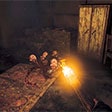Girls Games
Boys Games
Scary Games
Scary Games Online Play Free
In the poorly illuminated room, the sole origin of illumination emanates from the flickering gleam of the computer display. The ambiance is dense with stress as the player clutches the controller, prepared to immerse into the spine-chilling realm of scary games. These digital domains are shaped with scrupulous precision, intended to evoke a symphony of fear that reverberates profoundly within the player’s psyche.
As the unsettling music swells, the protagonist cautiously explores a deserted mansion, each creaking floorboard reverberating through the digital space. The visuals are so authentic that shadows dance threateningly in the corners, playing tricks on the mind. Every stride forward is accompanied by a sense of apprehension, as the unfamiliar lurks just beyond the edge of the display.
Delicately shaped ambiance intensifies the tension
Scary games are a testament to the potency of interactive storytelling. They engross players in narratives that send shudders down their spines, forming an encounter that surpasses traditional forms of amusement. The storyline twists and turns, weaving a story of terror.
The brilliance of scary games lies in their capacity to tap into primal fears. Whether it’s the portentous silence shattered by distant murmurs or the abrupt appearance of a grotesque creature, these apps exploit our deepest anxieties.




































































